Do cats have imagination? Read these definitions of the word and think about your cat. Do you see any way these definitions could apply to your cat?
Definitions of Imagination
Imagination is the “faculty or action of finding new ideas, images, or concepts of external objects not present to the senses.” Or how about this one? “Imagination is the ability of the mind to be creative and resourceful.“
When we think of a cat’s bad behavior, consider this: The behavior stems from the cat simply trying to get his needs met. If we do not provide what he needs, sometimes he must seek substitutes.
Yes, you got it — they have to use their imagination. Perhaps they find something of ours that they can “pretend” they stalk as prey. You don’t want that object to be kitty’s pretend prey? Then supply him with a variety of his own “stuff” that he can play with.
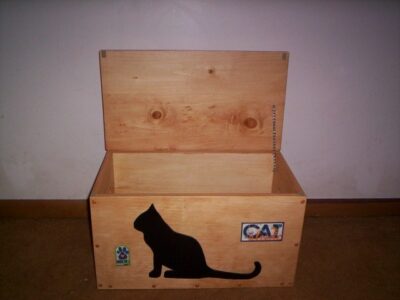
I’ve always kept a toy box for my cat, so he could go to it and choose the object that appealed to his interest at the moment. If you supply such a box (actually, I use a basket), change the toys in there now and then so kitty doesn’t get bored with them.
Kitty Is Trying To Communicate
Often a cat’s “bad” behavior represents kitty’s attempt to communicate a problem. If he does not use the litter box, but goes on the floor, what does he want to tell you? Perhaps the box needs cleaning and he doesn’t want to use it until you clean it.
Do you have a covered litter box? My cat, Pogo, landed in the animal shelter because he wouldn’t use his covered litter box. At my house he had two large litter boxes with no covers. His problem quickly disappeared.
Your cat has built-in instincts which cause him to act in a certain way, but now he must adjust to domestication, which changes everything. He gets his food in a dish, but then he still has this built-in need to observe prey, anticipate it, and then ambush it. How can he act on his instincts in your house?
The Importance Of Play
Through play! Play gives him a chance to imagine the hunt from start to finish. You can become a temporary player in this game if you can make his “hunt” seem more realistic. And, at the end, make sure your kitty catches his prey, so he does not become too frustrated. Help him fill his need for a successful hunt.
Your cat, when full-grown, sleeps a lot. Still, all that sleep makes it even more important for you to interact with him when he is awake and active.
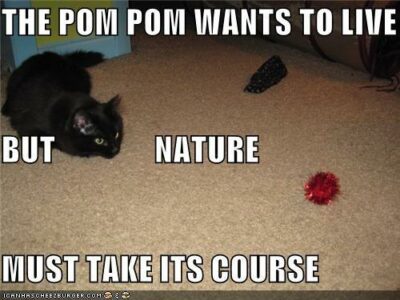
Here’s another good idea I gained from my research. Once the cat has stalked, chased, and caught his imaginary prey, give him the satisfaction of using the puzzle feeder to get a little snack. It gives kitty the feeling that he has caught his prey and can now enjoy treats from the puzzle box, providing the reward of ending a successful hunt with his prey for supper.
How Kittens Learn
Think about kittens playing together. Their mock battles mimic the real thing, and they use their imagination to make their play more real. From this boisterous play with their siblings, they learn much about being a cat.
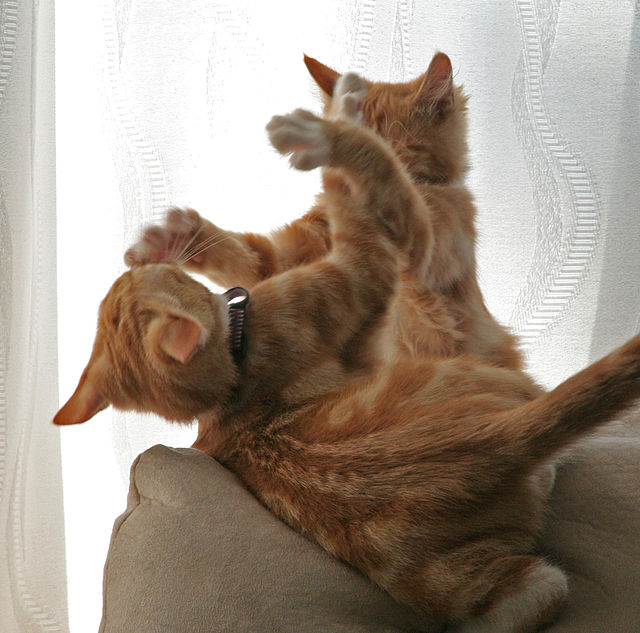
In fact, kittens learn many things through imaginative play, and it starts when they first open their eyes. At that stage, they use imagination to learn how to be a cat. Their only model becomes their mother. Mama cat has to teach them everything they know for the first few weeks.
This mimicking of mother is how the kitten determines its identity. We know this for truth because a kitten taken from its mother too early will sometimes mimic other creatures, such as dogs, humans, or even horses.
A Japanese study found that cats tend to track their owner’s movements around the house. The research supports the idea that cats retain a mental image of their owner, even if they can’t see them. This ability forms a very necessary bridge to the higher cognitive processes such as planning ahead and imagination.
Picturing The Invisible
The Japanese study showed that, since cats can mentally map their location based on their owner’s voice, it suggests that cats can picture the invisible in their minds.
For survival in the wild, the cat must have the ability to locate and track their prey, even if they cannot see it. The occasional rustle beneath the grass gives a clue, but then the cat must see the prey “in his mind’s eye” and follow it until he catches it successfully. In this case, imagination provides the information that will give the cat a fresh meal.
You actually fill an important need for your cat when you play with him. Kitty’s imagination will re-create the game in his mind, seeing it as a real-life hunting adventure. They need to chase and pounce, and if they cannot do the real thing, playing furnishes an adequate substitute.
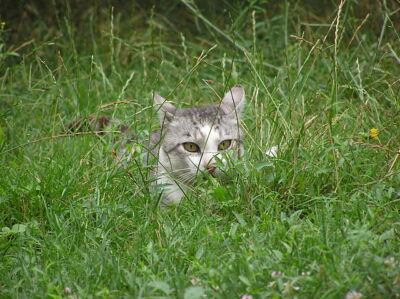
For the cat, he has to find a way to fill his needs, and the play hunt furnishes one example of a way to do so. He has other needs, such as scratching and climbing. If you try to get the cat to stop these behaviors, you make a mistake.
These activities fill a purpose for the cat, and if you want to discourage something that you don’t want the cat to do, you must supply an alternative way to fill that need. In this case, you might get a cat tree.
Help match the cat’s needs to his environment, and give him ways to deal with his needs. By doing so, you will have a happier, less stressed cat, and you will make his life with you much more satisfying.
With my cats, when they did something I did not understand, or didn’t want them to do, I would try to “become a cat.” I’d think about their behavior and try to work out what message they wanted to give me. Sometimes the explanation could be seen, and then it became possible to figure out a way to fill that need.
References I used for this post:
wayofcats.com/blog/power-of-imagination/12 theguardian.com/lifeandstyle/2021/nov/10/cats-track-their-owners-movements-research-finds petmd.com/cat/behavior/5-cat-cognition-facts deziroo.com/blogs/pawsitive-connections/how-cats-develop-through-pretend-play

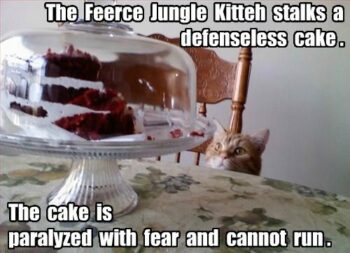
My cats have vivid imaginations. Fatboy loves to have a pinto bean to play with. He smacks it around the floor, stalks it, then he’ll look straight up in the air, make a growling noise, then pounce up in the air, landing on the bean in full target acquisition mode. He is a hoot.
He’ll run down the hallway, come flying back down at full speed, turn a corner or two, then nail that bean full-on. He’s been known to do the same without the bean at all. LOL
Cats can be so hilarious. I wonder what he is imagining when he plays with that bean? You should take a little video of his antics. It would be fun to share with other cat folks.
My cat Thomas is 14. He has a lot of toys that he can swat around and chase.
Sometimes he goes into lion mode and stares at a blank spot on the floor. He then jumps high in the air, lands on the blank spot, rolls over on his back and bites at a imaginary thing in his paws. He then moves and does it again. After 2 times he moves on to play with his toys.
I think Thomas imagines he is catching prey.
Oh, you are undoubtedly right, R. Peter! It’s a proven fact that cats have imagination, and it sounds like your cat, Thomas, has a very vivid one. I enjoyed your comment — hope you make more. You might enjoy the post that discusses how the cat’s brain is organized. They are such remarkable creatures!